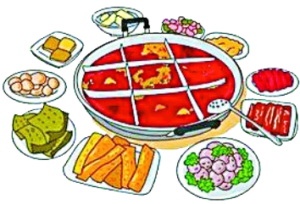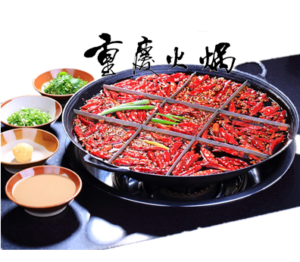Chongqing Hot Pot (重庆火锅)
Hotpot

The term hot pot (火鍋) refers to all Chinese hot pot dishes.
There are several kinds of hotpot in China, and the representative ones are Beijing hot pot (北京火鍋), Henan hot pot (河南火鍋) in the north part of China, Hunan hot pot (湖南火鍋) in the south, Chuanwei hot pot (川味火鍋) in Sichuan, and Guizhou hot pot in Guizhou (貴州火鍋).
Each of them is cooked using ingredients rooted in the local climate.
A simple example is the Mongolian hotpot (蒙古火鍋) in Inner Mongolia, which uses the famous lamb.
In Japan, it is also called sheep shabu-shabu.
Different hot pots have different soup, seasonings, and not all of them are spicy.
It’s a common mistake that people think hot pot got its name from hot (spicy) taste but actually the name comes from a pot with fire.
In Chinese hot (temperature) and fire have the same character “火” and “鍋”means pot)
In fact, Japanese non-spicy Nabe (鍋) such as Sukiyaki is called Japanese hot pot (日式火鍋) in China, so spiciness does not matter.
However, when people just say “hot pot” in China, it is likely that the they meant the most famous one which is a very spicy hot pot originated from Chongqing.
The reason why Chongqing hotpot becomes so popular is the shocking fragrance, spiciness and tastiness described later.
Origin of Hot Pot

Chongqing hot pot belongs to the category of Chuanwei hot pot (川味火锅)
Chuan (川) is a short form of Sichuan.
In China, it is called Chongqing hot pot (重庆火锅: Chongqing huoguo) or Mala hot pot (麻辣火锅: Mala huoguo).
“Ma” (麻) means numbness, and especially refers to the slight and comfortable numbness that comes from the Huajiao (花椒), Zanthoxylum or also called Sichuan Pepper.
If you have ever tried the authentic Sichuan Mapo doufu (麻婆豆腐), you must be familiar with the sensational fragrance and numbness in your tongue and lips.
In Chongqing there are numerous kinds of Huajiao having different shape, size, color, fragrance, flavor, and dryness, so the use of those pepper also differs.
Usually one hot pot is made of several (more than 10 is not rare) kinds of Huajiao.
Huajiao is the key of Chongqing hotpot and is also the secret behind the extremely tasty dishes in Chongqing.
On the other part, “La” (辣) refers to chili pepper.
Chongqing hot pot is made by blending several types of pepper.
There are different types of chili peppers with bright colors and strong flavor and they have different roles in hot pot.
For example, at the stage of seasoning soup, chili peppers with strong and spicy flavor are fried in wok to make the soup tasty, and those chilli peppers are removed from the wok once done.
Before serving to customers, chili peppers with beautiful color and aroma (but less spicy) are put into in the soup, which surprise customers’ eyes and nose.
It is not uncommon for people to eat the chili peppers in hot pot.
Especially Chongqing people have got used to the chili peppers since young so perhaps their body evolves (?) to digest the chili peppers easily.
But well… here I don’t recommend eating chili peppers for your stomach and health.
Origin of Chongqing Hot Pot

There are various stories regarding the origin of the Chongqing hot pot.
The most well-known story is related to boat shipping.
In the old days, Chongqing was a busy trading port where two rives meet at.
A lot of boats carry goods from the upper reaches of the Yangtze River and put down goods at Chongqing port.
When pulling up the boats back to the upper reaches, rope was attached to the boats floating on the river, and several men pulled the rope while walking on the shores.
It was hard task requiring a lot of energy, so the men who carried the boats were exhausted every day.
However, they were not financially rich so could not afford the meat carried by the boats.
Then, those men found out the intestines and organs of cows and pigs carried by the boats, which were supposed to be thrown away.
Thus, those men get intestines and organs from merchants for free and put it into a pot with spice.
Chongqing is extremely hot and humid, especially in summer, so those intestines and organs go rotten fast.
Boiling them in hot pot with a lot of chill pepper and Huajiao helps them lose the strong smell, and simultaneously flavor them nicely.
By eating the powerful hot pot, Chongqing men vitalize themselves to get power pulling up the ropes.
The landscape of Chongqing and the idea of those men created the Chongqing hot pot.
Gradually, the hot pot became known among merchants and ordinary people.
When they tried it, they quickly became the great fan of the unique taste.
Originally the ingredients and cooking methods were simple but the Chongqing hot pot has evolved over time,
Nowadays there are specialty stores of hot pot all over Chongqing, and it is said that there are about 26,000 hot pot stores today.
Hot Pot Restaurants

When you arrive at hot pot restaurant in Chongqing, you first select soup base.
You can choose mushroom base, seafood base, clear base, Chinese medicine base, Tomato base and etc. in addition to the authentic Mala flavor.
In Chongqing, the Mala favor is the most common among them.
Customers also can choose Yanyan pot (鴛鍋), which has two separate soup bases in a pot.
You can also specify the level of spiciness.
For those who are new to it, I recommend little spicy (小辣: Xiaola).
I must mention that the little spicy is already quite spicy in Chongqing.
Those who have a high tolerance of spiciness will ask for heavy spicy (重辣: Zhongla), which requires a bit of courage.
There are a wide variety of ingredients, such as meat (beef, pig, chicken, sheep, rabbit, frog, viscera, head, legs, brain miso, etc.), seafood (fish, shrimp, squid, octopus, eel, seaweed), vegetables, bean curd, noodles, and etc.
After ingredients arrive at table, customers boil them in pot soup, and take them in own bowl once ready.
Basically, sesame oil and garlic are added to the bowl, and chopped green onions, MSG, sugar, salt, soy sauce, sesame, corianders, and chili peppers are optional.
Putting boiled things into sesame oil has the effect of adding flavor and softening the heat and spiciness.
The standard ingredients are luncheon meat (午餐肉: spam), beef rumen (毛肚), meat dumplings and fish dumplings.
Specialty

Chongqing hot pot is rich in taste thanks to the use of beef fat.
This is one of the reasons why Chongqing hot pot is different from other kinds of hot pots.
In Chongqing, there is a type of hotpot called Jiugongge (九宫格火锅) that has nine divided spaces in a pot.
According to one story, when the living standard in Chongqing was poor, there was no custom of eating hot pots with family and friends, so it was common to share one pot with others.
Therefore, the nine-grid hot pot was created to make a personal space in the hot pot.
It is now common to have a hot pot with family and friends, but the Jiugongge hot pot is still enjoyed, and the nine grids are used to have different ingredients for each so that the ingredients do not mix.
In Chongqing, there is a type of hot pot called the old hot pot (老火锅: Lao huoguo).
The old hot pot is a hot pot that reheats the soup that has been used once, and sterilizes it sufficiently, and then takes out the surface of the soup and adding it again and again for many years.
The flavor of various ingredients melts into the soup over the years so the special rich taste is made.
When you visit Chongqing, please try various kinds of Chongqing hot pots!







Discussion
New Comments
No comments yet. Be the first one!